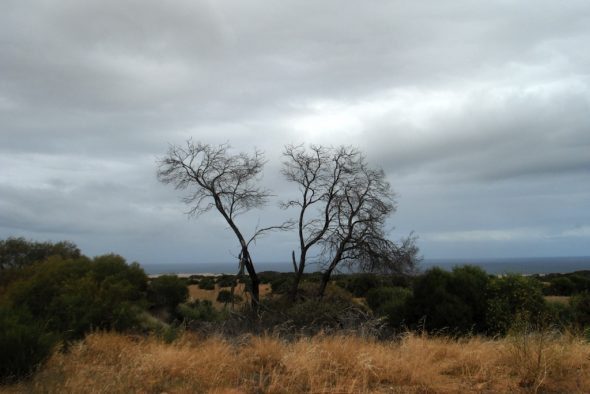Within decades, environments across Australia will be substantially different from those that currently exist.
CSIRO research released today suggests that, by 2030, climate change stress on our natural environments will be significant. By 2070, the impacts will be more widespread and, in many places, more extreme. Many parts of Australia will have environments that do not exist today anywhere on this continent.
Ecological stress
In a scientific first, we investigated how climate change will affect plants, animals and ecosystems across the entire continent.
We found large, ecologically-relevant environmental change for most of the continent. We can expect changes in species distribution and abundance, changes in ecosystem composition and structure (woodland becoming grassland, for example), and changes in how ecosystems function.
We found that the degree of ecological stress is less, or at least develops more slowly, in a climate change scenario where greenhouse gas emissions are lower than the so called “business as usual” scenario. In this lower emission scenario, both biodiversity and conservation institutions will have more time to adapt to the changing climate.
Prediction about the details of change and likely loss of biodiversity are difficult due to the various processes of ecological change, and the differing affects of climate change-induced stress. But we are confident of one thing. Rapid ecological change will be an important feature of Australian landscapes in the future. The bush will look, smell and sound very different 50 years from now.
Accepting change
So what does this oncoming change mean for conservation and environmental management in Australia?
Traditionally, conservation theory and practice are mostly about preventing or reversing ecological change – preserving nature in some idealised, unchanging state. Our research implies that this approach may not be possible in the future. We need to adapt our thinking, policies and on-the-ground actions to a situation where change is the new norm.
Of course, minimising the extinction of species should still be a fundamental goal. But doing so may require different approaches than we currently use. This change in conservation thinking will require a broad conversation including government, conservation groups and the public.
Future conservation efforts may need to focus on the existence of species (rather than their abundance and distribution), the health of ecosystems, and the balance of natural and human activities across whole landscapes. It will become more a question of managing change, perhaps even facilitating it in some circumstances, rather than preventing it.
The risk of extinction
The total number of species becoming extinct and at risk of extinction is likely to be considerably greater in the future.
With limited resources and many threatened species, it may be more beneficial overall to prioritise effort on species that have greater likelihood of surviving, rather than the most vulnerable. Naturally, this raises questions about society’s value of particular species that will need to be discussed.
People also value living landscapes for their aesthetic, cultural and production values. Future conservation objectives will need to address how to conserve these values as ecosystems and land uses change in response to the climate.
Current biodiversity management strategies largely assume low levels of species loss, relatively high levels of knowledge about threats and the state of biodiversity, and relatively static environments. These strategies will be less effective as high levels of change occur and uncertainty increases.
Beyond the national park
We found that protected natural areas such as national parks and indigenous protected areas will continue to play a key role in biodiversity conservation. But, given the increased level of threat and the need to allow movement of species in response to pressures from climate change, additional areas of habitat, outside the protected area system, will be increasingly important. These areas will provide additional and alternate habitats for species, and support ecological processes across whole landscapes.
It will be increasingly important to manage ecological change at very large landscape scales.
Larger, diverse areas of habitat will help species survive the multiple pressures arising from climate change, which are likely to affect ecosystems beyond the scale of individual habitat patches or nature reserves. This can be accomplished by ensuring existing large areas of intact habitat are protected from clearing and degradation, and by connecting smaller patches by restoring and maintaining links between otherwise isolated areas.
Interaction with other sectors
Many aspects of Australian landscapes will change as various sectors for example primary industries, water management, bush fire management and tourism, adapt to climate change.
It is possible that responses in the other sectors could add to the climate change stress and further threaten biodiversity.
On the other hand, certain changes in land use could be beneficial if designed also to sustain biodiversity.
Given the scale of change, the differing values, and the need for broad management strategies, it is time to start a conversation.
It will be essential for conservation institutions to engage with local natural resource management bodies, conservation groups, and the general public around the changes that will determine the future of Australia’s natural environment.
David Hilbert is Principal Research Scientist, CSIRO Ecosystem Sciences at CSIRO
This article was originally published on The Conversation – theconversation.edu.au. Reproduced with permission.










